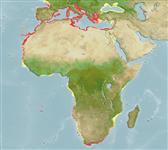>
Eupercaria/misc (Various families in series Eupercaria) >
Sparidae (Porgies)
Etymology: Diplodus: Greek, diploos = twice + Greek, odous = teeth (Ref. 45335).
More on author: Linnaeus.
Issue
This subspecies is reported to have no genetic difference between the subspecies Diplodus sargus cadenati. See V.S. Domingues et al. 2007. Journal of Experimental Marine Biology and Ecology 346 (2007):102-113 (F. M. Porteiro, pers.comm. 02/08). Presence in Canary Is. to be reviewed since D. bellottii and D. cadenati are recognized as valid species, not any more as subspecies of D. sargus.
Environment: milieu / climate zone / depth range / distribution range
экология
морской; солоноватоводный демерсальный; мигрирует в океане (Ref. 51243); пределы глубины 0 - 50 m (Ref. 12460), usually 0 - 50 m (Ref. 13780). Subtropical; 48°N - 36°S, 29°W - 42°E
Northeastern Atlantic from Brittany (France) to Gibraltar, and Madeira I.; Mediterranean Sea and southwestern Black Sea.
Length at first maturity / Size / Вес / Возраст
Maturity: Lm ?, range 25 - ? cm
Max length : 45.0 cm TL самец/пол неопределен; (Ref. 3397); common length : 22.0 cm TL самец/пол неопределен; (Ref. 3397); наибольший вес (опубликованные данные): 1.9 kg (Ref. 40637); наибольший возраст (опубликованны данные): 10 годы (Ref. 26328)
колючие лучи спинного плавника (общее число) : 11 - 12; членистые (мягкие) лучи спинного плавника (общее число) : 12 - 15; колючие лучи анального плавника: 3; членистые (мягкие) лучи анального плавника: 11 - 14. Body with 5 black and 4 grey vertical bands. Snout is longer than the eye diameter (Ref. 35388).
Inhabits coastal rocky reef areas (Ref. 12460) and Posidonia oceanica beds. Like other sparids, it is very active and frequents the surf zone, primarily at dawn (Ref. 13780). Feeds on shellfish and other benthic invertebrates which it picks from the sediment (Ref. 5377).
Sexes separate or protandrous (Ref. 4781). In some areas, this species occurs as a digynic hermaphrodite, that is, males and females developing from intermediate juveniles (Ref. 52202). However, protandry with possible digyny was later confirmed (Ref. 103751). Reaches sexual maturity at 2 years, with an approximate size of 17 cm. Spawning happens from January to March. Egg size 0.8-0.9 mm; larval length at hatching 2.6 mm. Also Ref. 28504.
Bauchot, M.-L., 1987. Poissons osseux. p. 891-1421. In W. Fischer, M.L. Bauchot and M. Schneider (eds.) Fiches FAO d'identification pour les besoins de la pêche. (rev. 1). Méditerranée et mer Noire. Zone de pêche 37. Vol. II. Commission des Communautés Européennes and FAO, Rome. (Ref. 3397)
Статус Красного Списка МСОП (Ref. 130435: Version 2024-1)
Угроза для людей
Harmless
Использование человеком
рыболовство: не имеет хозяйственного значения; аквакультура (рыбоводство): коммерческий; объект спортивного рыболовства: да
дополнительная информация
инструменты
Специальные отчеты
Скачать в формате XML
ресурсы в Интернет
Estimates based on models
Preferred temperature (Ref.
123201): 15 - 24.1, mean 18.8 °C (based on 400 cells).
Phylogenetic diversity index (Ref.
82804): PD
50 = 0.5000 [Uniqueness, from 0.5 = low to 2.0 = high].
Bayesian length-weight: a=0.01175 (0.01049 - 0.01316), b=3.04 (3.01 - 3.07), in cm total length, based on LWR estimates for this species (Ref.
93245).
Trophic level (Ref.
69278): 3.4 ±0.1 se; based on diet studies.
устойчивость к внешним воздействиям (Ref.
120179): средний (среднего размера), минимальное время удвоения популяции 1.4-4.4 года (K=0.11-0.25; tmax=10; tm=2).
Prior r = 0.54, 95% CL = 0.35 - 0.80, Based on 5 data-limited stock assessments.
Fishing Vulnerability (Ref.
59153): High vulnerability (57 of 100).
Climate Vulnerability (Ref.
125649): Low to moderate vulnerability (26 of 100).
Nutrients (Ref.
124155): Calcium = 74.5 [38.6, 152.0] mg/100g; Iron = 0.993 [0.559, 1.844] mg/100g; Protein = 19.7 [18.8, 20.6] %; Omega3 = 0.35 [0.20, 0.60] g/100g; Selenium = 20.9 [9.8, 39.7] μg/100g; VitaminA = 15 [5, 42] μg/100g; Zinc = 1.01 [0.69, 1.43] mg/100g (wet weight); based on
nutrient studies.
